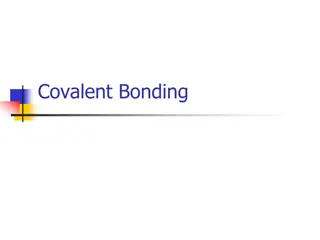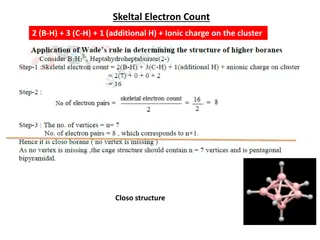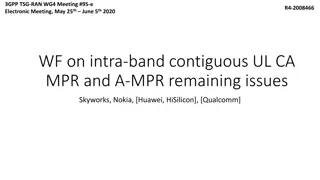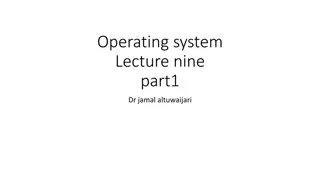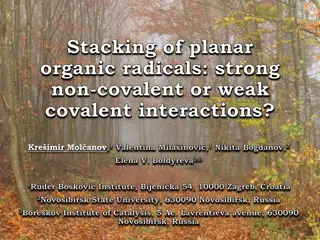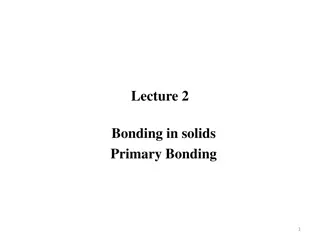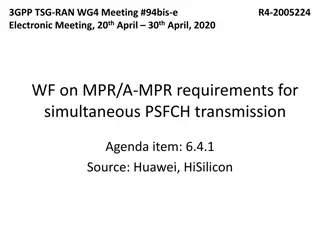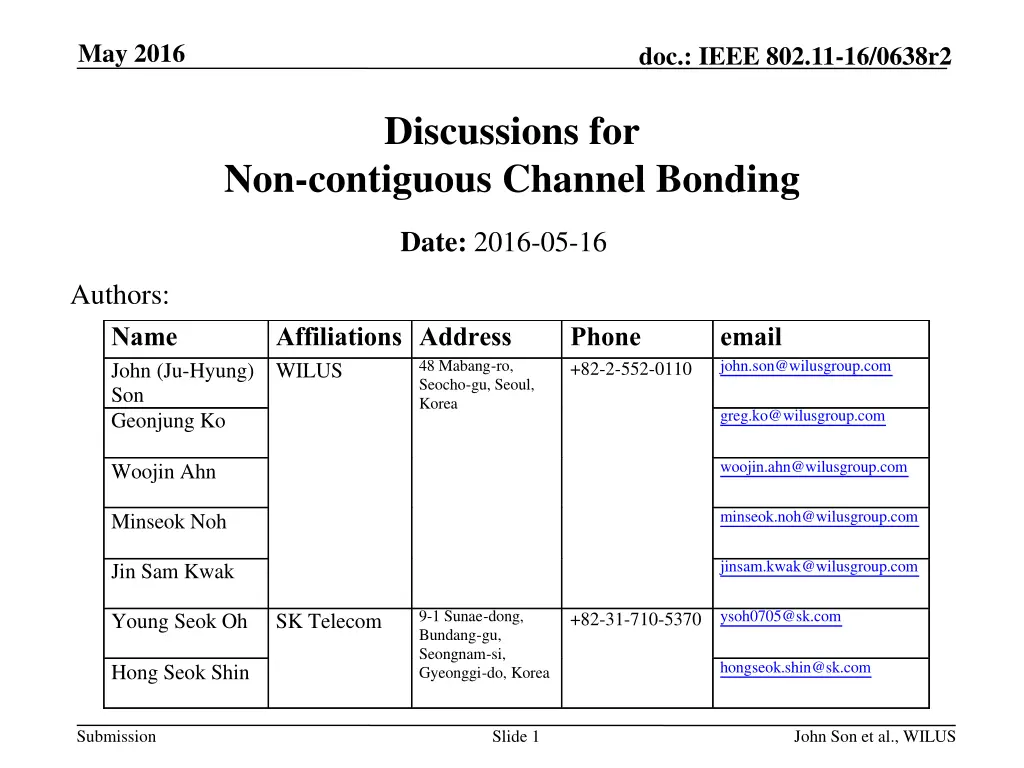
IEEE 802.11-16/0638r2 Non-contiguous Channel Bonding Discussions
Explore discussions on non-contiguous channel bonding in IEEE 802.11-16/0638r2, focusing on issues related to signaling, interference, and transmission modes. Learn about the implications for OFDMA PPDU transmission and the signaling of non-contiguous bandwidth options in HE-MU PPDU.
Download Presentation

Please find below an Image/Link to download the presentation.
The content on the website is provided AS IS for your information and personal use only. It may not be sold, licensed, or shared on other websites without obtaining consent from the author. If you encounter any issues during the download, it is possible that the publisher has removed the file from their server.
You are allowed to download the files provided on this website for personal or commercial use, subject to the condition that they are used lawfully. All files are the property of their respective owners.
The content on the website is provided AS IS for your information and personal use only. It may not be sold, licensed, or shared on other websites without obtaining consent from the author.
E N D
Presentation Transcript
May 2016 doc.: IEEE 802.11-16/0638r2 Discussions for Non-contiguous Channel Bonding Date: 2016-05-16 Authors: Name John (Ju-Hyung) Son Geonjung Ko Affiliations Address WILUS Phone +82-2-552-0110 email john.son@wilusgroup.com 48 Mabang-ro, Seocho-gu, Seoul, Korea greg.ko@wilusgroup.com woojin.ahn@wilusgroup.com Woojin Ahn minseok.noh@wilusgroup.com Minseok Noh jinsam.kwak@wilusgroup.com Jin Sam Kwak 9-1 Sunae-dong, Bundang-gu, Seongnam-si, Gyeonggi-do, Korea ysoh0705@sk.com +82-31-710-5370 Young Seok Oh SK Telecom hongseok.shin@sk.com Hong Seok Shin Submission Slide 1 John Son et al., WILUS
May 2016 doc.: IEEE 802.11-16/0638r2 Introduction 11ax D0.1 specifies non-contiguous channel bonding as follows [1] The HE PHY provides support for 20 MHz, 40 MHz, 80 MHz and 160 MHz contiguous channel widths and support for 80+80 MHz non-contiguous channel width. Tones of one or more secondary channels in 80 MHz and 160 (80+80) MHz could be nulled when using OFDMA PPDU transmission. The modes of non-contiguous channel bonding are TBD. The non-contiguous channels within primary or secondary 80 MHz only exists at AP side. In this submission, we discuss several issues related to the non- contiguous channel bonding signaling of non-contiguous channel bonding in SIG-A/B transmission of the center 26-tone RU when the adjacent channel is nulled interferences to OBSS on-going transmissions in nulled channels Submission Slide 2 John Son et al., WILUS
May 2016 doc.: IEEE 802.11-16/0638r2 HE-SIG-A s BW field R L- SIG HE- SIG-A HE- SIG-B HE- LTF(s) L-STFL-LTFL- HE- STF PSDU(s) SIG HE MU PPDU In HE MU PPDU, SIG-A s BW field is TBD that may accommodate more bandwidth options than in SU case 11ax may extend SIG-A s BW field to explicitly signal non-contiguous bandwidth options (e.g. P20+S40) Not many bit spaces left for the BW field 16 bits are remained for Spatial Reuse, TXOP, and BW fields Field # of Bits UL/DL 1 BSS Color 6 Spatial Reuse TBD TXOP Duration TBD Bandwidth >=2 SIG-B MCS 3 SIG-B DCM 1 SIG-B Num of SYM SIG-B Compression 4 1 Num of HE-LTF SYM CP+LTF Size 3 3 LDPC Extra SYM 1 Packet Extension 3 CRC 4 Tail 6 Total 36 +SR+TXOP+BW =52 Submission Slide 3 John Son et al., WILUS
May 2016 doc.: IEEE 802.11-16/0638r2 HE-SIG-B s Common Block field RU (A1) ... RU (An) RU (Bn) ... RU (Bn) A HE- SIG-A HE-SIG-B (A,C) L-Part P20 Dup. HE- SIG-A B Dup. L-Part HE-SIG-B (B,D) S20 HE- RU (X) STF/LTF Dup. HE- SIG-A RU (C1) ... RU (Cn) C Dup. L-Part HE-SIG-B (A,C) S40A Dup. HE- SIG-A RU (D1) ... RU (Dn) D Dup. L-LTF HE-SIG-B (B,D) S40B HE-SIG-B (A,C) 1st content channel STA A1 STA An STA C1 STA Cn RA A RA C ... ... C/T C/T C/T C/T STA X C/T TBD HE-SIG-B (B,D) 2nd content channel STA B1 STA Bn RA B RA D STA D1 STA Dn ... C/T C/T ... C/T *C/T: CRC/Tail Common Block field User Specific field Two HE-SIG-B content channels are parallel-decoded at receiving STAs In Common Block, RU allocation subfield signals RU arrangements in frequency domain and the number of User specific subfields RU allocation subfield may signal Null RU indices to signal non- contiguous PPDU options (currently many TBD index ranges) Submission Slide 4 John Son et al., WILUS
May 2016 doc.: IEEE 802.11-16/0638r2 Signaling of non-contiguous channel-bonding RU (A1) ... RU (An) RU (Bn) ... RU (Bn) A HE- SIG-A HE-SIG-B (A,C) L-Part P20 Dup. HE- SIG-A B Dup. L-Part HE-SIG-B (B,D) S20 HE- RU (X) STF/LTF Dup. HE- SIG-A RU (C1) ... RU (Cn) C Dup. L-Part HE-SIG-B (A,C) S40A Dup. HE- SIG-A RU (D1) ... RU (Dn) D Dup. L-LTF HE-SIG-B (B,D) nulled channel S40B (A) BW (B) Common Block AP can signal non-contiguous channel based PPDU constructions by (A) Using SIG-A s BW field (B) Using SIG-B s Common Block (RU allocation subfield) (C) Using both SIG-A & SIG-B Submission Slide 5 John Son et al., WILUS
May 2016 doc.: IEEE 802.11-16/0638r2 Signaling of non-contiguous channel bonding Objectives Support various non-contiguous channel bonding options Minimum signaling overhead on SIG-A/B Limitations/Requirements PPDU shall occupy Primary 20MHz Support parallel decoding of SIG-B content channels Fixed location of the second SIG-B content channel Limit non-contiguous channel bonding rule to always occupy Primary 40 Flexible location of the second SIG-B content channel (within Primary 80) SIG-A signals the location of the second SIG-B channel No ambiguity on the number of common blocks in SIG-B With SIG-A s signaling, receiving STAs should know the size of the common block field in SIG-B Submission Slide 6 John Son et al., WILUS
May 2016 doc.: IEEE 802.11-16/0638r2 Option (A) SIG-A only signaling SIG-ASIG-B 1st SIG-B Content Channel L-Pre 1 Dup. L-Pre Dup. SIG-A SIG-B 2 HE- STF /LTF MU Data Dup. SIG-B 1 Dup. L-Pre Dup. SIG-A Location of the 2nd SIG-B Channel 2nd SIG-B Content Channel Dup. SIG-B 2 Dup. L-Pre Dup. SIG-A User Specific Comm. Block BW ... ... Size of the Common Block (A) Using SIG-A s BW field Extend SIG-A s BW field to signal non-contiguous channel bandwidth options (e.g. P20+S40) BW field should clearly indicate the location of the 2nd SIG-B content channel (if it is not fixed) and the size of the common block Submission Slide 7 John Son et al., WILUS
May 2016 doc.: IEEE 802.11-16/0638r2 Option (B) SIG-B only signaling RU (A1) ... RU (An) RU (Bn) ... RU (Bn) A SIG-B (A,C) CCA (idle) L-Part SIG-A P20 Dup. HE- SIG-A B Dup. L-Part SIG-B (B,D) CCA (idle) S20 HE- RU (X) STF/LTF Dup. HE- SIG-A Dup. SIG-B (A,C) RU (C1) ... RU (Cn) C CCA (idle) Dup. L-Part S40A Dup. HE- SIG-A RU (D1) ... RU (Dn) Dup. SIG-B (B,D) D CCA (busy) Dup. L-LTF nulled channel S40B RU allocation # of Entries ... 1 1 1 indices #1 #2 #3 #4 #5 #6 #7 #8 #9 HE-SIG-B (A,C) STA A1 STA An STA C1 STA Cn RA A RA C ... ... C/T C/T C/T C/T ... ... TBD TBD TBD 242 Null 484 Null 996 Null ... STA D1 STA Dn STA B1 STA Bn RA B RA D HE-SIG-B (B,D) ... ... C/T C/T C/T (B) Using SIG-B s Common Block field SIG-A signals the current 4 BW options (20/40/80/160) Add additional Null RU indices to the current RU allocation definition (currently there are many TBD index ranges) RU allocation subfield signals 242/484/996 Null to indicate nulled secondary channels No user specific subfields are sent corresponding to the Null RUs No additional signaling overheads on SIG-A/B bit fields compared to the current design The Null RU indices can be reused in MU-MIMO signaling load balancing scenarios [2] Submission Slide 8 John Son et al., WILUS
May 2016 doc.: IEEE 802.11-16/0638r2 Option (C) SIG-A+SIG-B signaling (C) Using both SIG-A and SIG-B to signal non- contiguous channel bonding options SIG-A SIG-A s BW field signals limited information for non-contiguous PPDU BW Even with the limited signaling, there should be no ambiguity of Location of secondary SIG-B content channel (if it is dynamic) Number of SIG-B s common block SIG-B Further signaling of nulled secondary RUs Submission Slide 9 John Son et al., WILUS
May 2016 doc.: IEEE 802.11-16/0638r2 Transmission of the center 26-tone RU RU (A1) ... RU (An) RU (Bn) ... RU (Bn) HE- SIG-A HE-SIG-B (A,C) L-Part Dup. HE- SIG-A Dup. L-Part HE-SIG-B (B,D) HE- the center 26-tone RU should also be nulled RU (X) STF/LTF Dup. HE- SIG-A RU (C1) ... RU (Cn) Dup. L-Part HE-SIG-B (A,C) nulled secondary channel Dup. HE- SIG-A RU (D1) ... RU (Dn) Dup. L-LTF HE-SIG-B (B,D) In 80MHz OFDMA, there is a center 26-tone RU and its signaling within HE-SIG-B content channels is TBD (e.g. 1st or 2nd, fixed or dynamic) In non-contiguous channel PPDU, when a secondary channel adjacent to the center 26-tone RU is nulled, the center 26-tone RU also should be nulled HE-SIG-B signaling should explicitly identify the existence of the center 26-tone RU even with the decoding failure of one SIG-B content channel Submission Slide 10 John Son et al., WILUS
May 2016 doc.: IEEE 802.11-16/0638r2 Interferences to OBSS P20MHz S20MHz S40MHz Nulled 20MHz 80MHz Spectral Mask (example) may interfere OBSS s on-going transmissions in nulled channels Non-contiguous PPDU transmission may interfere OBSS s on-going transmission due to the limited guard carriers adjacent to the nulled channel TGax needs further discussions on how to minimize OBSS interferences in non-contiguous channel bonding Submission Slide 11 John Son et al., WILUS
May 2016 doc.: IEEE 802.11-16/0638r2 Conclusions In this submission, we discussed several issues related to the non-contiguous channel bonding 1. Signaling of non-contiguous channel bonding by using SIG-A, SIG-B or SIG-A/B 2. Transmission of the center 26-tone RU in non-contiguous channel bonding 3. How to minimize interferences to on-going OBSS PPDUs in nulled channels Submission Slide 12 John Son et al., WILUS
May 2016 doc.: IEEE 802.11-16/0638r2 References [1] 11-16/0024r1, Proposed TGax draft spec [2] 11-16/0039r1, RU Allocation in SIG-B [3] 11-16/0045r1, Flexible Wider Bandwidth Transmission [4] 11-16/0059r1, Non-contiguous Channel Bonding in 11ax [5] 11-16/0397r2, HE-SIG-B signaling discussions Submission Slide 13 John Son et al., WILUS
May 2016 doc.: IEEE 802.11-16/0638r2 Straw poll Do you agree to add the following underlined text into 11ax SFD ? 3.1 General The non-contiguous channel bonding will be supported in 802.11ax by: Transmitting using OFDMA PPDU format by nulling the tones of one or more secondary channels in 80 MHz and 160 (80+80) MHz; Modes for non-contiguous channel bonding are TBD; Non-contiguous channels within primary or secondary 80 MHz only exists at AP side. When a secondary channel which is fully or partially overlapped with a center 26-tone RU is nulled, the center 26-tone RU is also nulled. Y/N/A Submission Slide 14 John Son et al., WILUS





